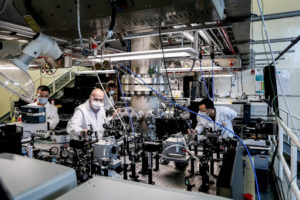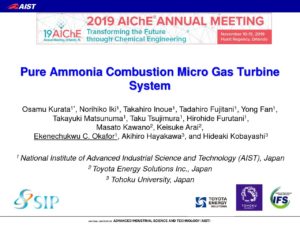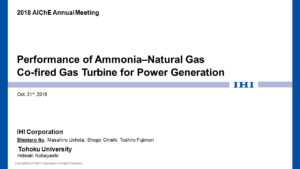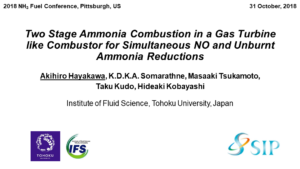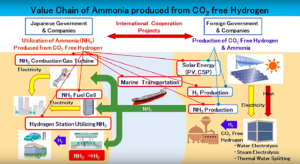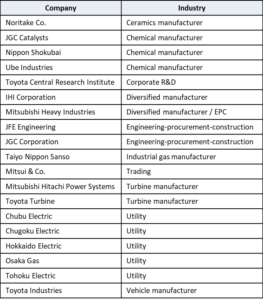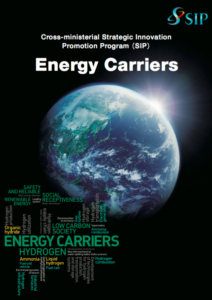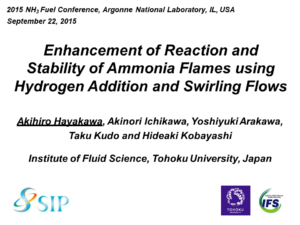Japanese government funding via NEDO will support four critical ammonia energy projects, including JERA's new plan to demonstrate 50% ammonia-coal co-firing by 2030. Other projects include improved catalysts for ammonia production, low-temperature and low-pressure synthesis pathways, and developing 100% ammonia-fed boilers and gas turbines. In addition, a new cooperation agreement between ASEAN countries will see Japan support other members to adopt their ammonia energy solutions, particularly coal co-firing.
Content Related to Tohoku University
Cardiff-KAUST-Tohoku Young Researcher Workshop on Ammonia Energy
Organised by a panel of young researchers — and for young researchers — Cardiff University, KAUST and Tohoku University hosted a virtual workshop on ammonia energy. Each group showed their most recent research developments through the two-day event, attracting 50+ participants from the three groups alone. The event included research introductions from the research leaders of each group as well as quizzes, discussion rooms, prizes. Each group selected 6 early career presenters to feature their latest work in the topics of chemistry and microflow reactors, laminar and turbulent flames and applications. Taking advantage of the discussion sessions, this workshop hopes to promote large scale international collaboration and a researcher exchange programme in ammonia energy.
A Deep Dive into SIP "Energy Carriers" Ammonia Combustion Research
From 2014 to 2018 Bunro Shiozawa served as Deputy Program Director of the SIP “Energy Carriers” initiative in Japan. Over the last year he has published a ten-part series of articles that describe and reflect on the research supported by the initiative. Part 4 covers ammonia combustion technologies. The first half of the article follows, in Shiozawa's English translation. The second half will be posted in the near future.
Pure Ammonia Combustion Micro Gas Turbine System
Ammonia Gas Turbines on European R&D List
ETN Global’s latest R&D Recommendation was released in October 2018. ETN stands for European Turbine Network and its technology of interest is the gas turbine. The 2018 Recommendation is notable because it is the first that includes ammonia on the R&D agenda.
Performance of Ammonia-Natural Gas Co-Fired Gas Turbine for Power Generation
Two Stage Ammonia Combustion in a Gas Turbine like Combustor for Simultaneous NO and Unburnt Ammonia Reductions
Development of Low-NOx Combustor of Micro Gas Turbine Firing Ammonia Gas
Full program announced for the 2018 NH3 Event Europe
The second annual European Conference on Sustainable Ammonia Solutions has announced its full program, spread over two days, May 17 and 18, 2018, at Rotterdam Zoo in the Netherlands. The international cadre of speakers, representing a dozen countries from across Europe as well as the US, Canada, Israel, and Japan, will describe global developments in ammonia energy from the perspectives of industry, academia, and government agencies.
Methods for Low NOx Combustion in Ammonia / Natural Gas Dual Fuel Gas Turbine Combustor
Combustion Emissions from NH3 Fuel Gas Turbine Power Generation Demonstrated
254th ACS Meeting, Energy and Fuels Symposium “The Ammonia Economy” — Oxidation, Catalytic Cracking & Storage
In August of 2017 a symposium on the Ammonia Economy was held in Washington DC as part of the Energy and Fuels Division of the American Chemical Society (ACS) conference. The symposium was devised to explore the latest results from ammonia related research, including but not limited to; advances in the generation of ammonia, advances in the catalytic cracking of ammonia to nitrogen and hydrogen, ammonia storage and utilisation, detectors and sensors for ammonia, ammonia fuel cells and hydrogen from ammonia, ammonia combustion and ammonia safety.
SIP "Energy Carriers" video: ammonia turbines, industrial furnaces, fuel cells
To demonstrate the progress of the SIP "Energy Carriers" program, the Japan Science and Technology Agency last week released a video, embedded below, that shows three of its ammonia fuel research and development projects in operation. R&D is often an abstract idea: this video shows what it looks like to generate power from ammonia. As it turns out, fuel cells aren't hugely photogenic. Nonetheless, if a picture is worth a thousand words, this will be a long article.
Advances in Ammonia-Fired Gas Turbines Open Up Major Use Case
In the last 12 months ... Researchers seeking to fire gas turbines with ammonia made significant strides toward realization of commercial-scale machines in both the U.K. and Japan. This means that electricity generation has become a realistic near-term use-case for ammonia energy.
Green Ammonia Consortium: Bright Prospects in Japan for Ammonia as an Energy Carrier
In the last 12 months ... In July 2017, 19 companies and three research institutions came together to form the Green Ammonia Consortium. Before this development, it was unclear whether ammonia would find a significant role in Japan’s hydrogen economy. In the wake of this announcement, however, ammonia seems to have claimed the leading position in the race among potential energy carriers.
Major Development for Ammonia Energy in Japan
On July 25, the Japan Science and Technology Agency (JST) announced that a collection of companies and research institutions had come together to form a Green Ammonia Consortium. The 22-member group will take over responsibility for the ammonia aspect of the Cross-Ministerial Strategic Innovation Program (SIP) Energy Carriers agenda when the SIP is discontinued at the end of fiscal 2018. A JST press release states that the Consortium intends to develop a strategy for “forming [an] ammonia value chain,” promote demonstration projects that can further commercialization, and enable “Japanese industry to lead the world market.”
Industrial demonstrations of ammonia fuel in Japan
Most of the ammonia energy projects I write about are in the research and development phase but, as I've said before, technology transfer from the academic lab to commercial deployment is moving swiftly - especially in Japan. Last week, Nikkei Asian Review published two articles outlining plans by major engineering and power firms to build utility-scale demonstrations using ammonia as a fuel for electricity generation. Both projects aim to reduce the carbon intensity of the Japanese electrical grid, incrementally but significantly, by displacing a portion of the fossil fuels with ammonia. The first project will generate power using an ammonia-coal mix, while the second will combine ammonia with natural gas.
Ammonia-Fueled Gas Turbine Power Generation
Hideaki Kobayashi, professor at the Institute of Fluid Science at Tohoku University in Sendai, Japan, has developed the world’s first technology for direct combustion of ammonia in a gas turbine. The advance was made in cooperation with the National Institute of Advanced Industrial Science and Technology (AIST) under a program led by Norihiko Iki.
Ammonia Turbine Power Generation with Reduced NOx
A common concern with ammonia fuel is that NOx emissions will be too high to control. However, in new research from Turkey, USA, and Japan, presented at this year's NH3 Fuel Conference in September 2016, two things became clear. First, NOx emissions can be reduced to less than 10ppm by employing good engineering design and exploiting the chemical properties of ammonia, which plays a dual role as both the fuel and the emissions-cleanup agent. Second, the deployment of ammonia-fueled turbines for power generation is not only feasible, but actively being developed, with demonstration units running today and improved demonstration projects currently in development.
Development of ammonia / natural gas dual fuel gas turbine combustor
Combustion characteristics of ammonia/air flames for a model swirl burner and an actual gas turbine combustor
Power Generation and Flame Visualization of Micro Gas Turbine Firing Ammonia or Ammonia-Methane Mixture
Enhancement of reaction and stability of ammonia flames using hydrogen addition and swirling flow
Combustion characteristics of ammonia/natural gas dual fuel burner for gas turbine combustor
Micro Gas Turbine Firing Ammonia
Fundamental Characteristics of Ammonia/Air Premixed Laminar Flames

